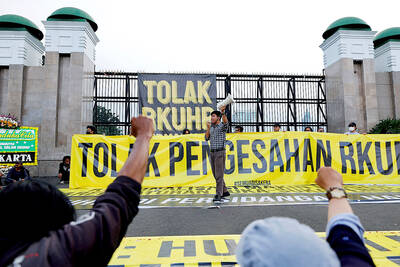When Indian national Prem Purswaney arrived in Taiwan, like many expats he only intended to stay for a short time. That was 23 years ago.
Prem, born in Rajasthan, but raised in Dubai, arrived in October 1985 to do a short-term apprenticeship with his uncle’s trading company.
Before long, six months had turned into six years. Then, in 1992 he met Priya, a fellow Indian living in Taiwan, who he married two years later.
The couple now have two children, a daughter, 10, and a five-year-old son — both born here — and are still in Taiwan. A place they have come to love and now call home.
“We even get homesick when we return to India to see our family,” Priya said.
Back in the early days, Prem said, Taiwanese people knew little about India and he often got annoyed at the stereotypes he faced whenever he took a taxi.
“Drivers would often ask why I ate with my hand, why Indian women had spots [bindis] on their forehead and about the hot and spicy food,” he said.
Nowadays, the same drivers are more likely to ask him about the IT industry and India’s expertise in computer software.
This is a sign of how things have changed, and the increasingly close relationship that has formed between the two countries as ties have increased over the last two decades.
“When our office opened in 1995, there was very little bilateral trade,” India-Taipei Association Director General T. P. Seetharam said.
By 2006, annual trade had grown to US$2.8 billion. Last year that figure had increased to US$5.38 billion.
“But there is still much room for improvement,” he added.
Surprisingly, software — considered one of India’s strengths — isn’t a large contributor to its trade with Taiwan.
Seetharam puts that partly down to language differences and the fact that Indian software companies usually concentrate on Western markets.
But, he added, there are many other exchanges, both industrial and academic, in high-tech fields such as biotechnology and materials technology.
These exchanges have led to a mini influx of Indians into Taiwan, with small groups of Indian nationals springing up in several locations near the country’s larger universities, most notably in Hsinchu and Taipei.
“There are almost 100 Indian scientists alone at Academia Sinica,” he added.
Rajendra Prasad Janapatla, 32, from Hyderabad, has been in Tainan for three years conducting post-doctoral research in microbiology at National Cheng Kung University.
Raj, as his friends call him, said he enjoys life in Taiwan as it is much less hassle than in India, although he believes the locals, though friendly and helpful, are too shy when it comes to socializing with foreigners.
Like most expats here, Raj also has a few complaints.
“Many Indians complain that they only get seven days paid vacation per year,” he told the Taipei Times by e-mail. “Visa extensions are also annoying,” he said, “because if a contract is for 12 months, the authorities only give you 12 months, not one or two months extra like in the US or Europe.”
In addition to these high-tech newcomers, “There are two major Indian communities which have been here for longer,” Seetharam said.
First, there is “a community of traders — who buy and sell things around the globe,” he added. This community (which speaks the Sindhi language) used to have around 200 families, but now numbers only 40 or 50 as the majority of them have migrated to China, mainly to Guangzhou, along with Taiwan’s manufacturing.
Another, similar-sized, group is made up of families in the diamond and precious stones trade who sell their wares to Taiwanese jewelers.
Despite the increased contacts, it may surprise many to learn that according to official immigration figures, as of last August there were only around 1,900 long-term Indian residents in Taiwan — although this number had increased from 1,400 a year earlier.
Even so, signs of an increased awareness of India and its culture are visible on the streets of Taiwan’s cities.
Yoga is one of the most obvious examples, with schools devoted to the ancient art literally on every other corner. Inspiration from Bollywood movies, meanwhile, has seen Indian dancing gain an increasing number of devotees.
Indian fashions are popular among the young and can be purchased at most night markets, while those who fancy some pampering can check into one of the many ayurvedic spas that are cropping up in big hotels and beauty salons nationwide.
Chengchi University is working on a textbook about India — its politics, economics and culture — with the aim of helping the nation’s university students gain a deeper understanding of this giant melting pot of a country.
Then there is Indian food, which can now be found at more and more locations across Taiwan.
“Even the Indian fare on offer at some of Taipei’s Western restaurants is pretty authentic,” Purswaney said.
With so much bilateral contact these days, it seems the only stereotypes Indians in Taiwan like Purswaney will have to put up with in the future will be positive ones.

Shamans in Peru on Monday gathered for an annual New Year’s ritual where they made predictions for the year to come, including illness for US President Donald Trump and the downfall of Venezuelan President Nicolas Maduro. “The United States should prepare itself because Donald Trump will fall seriously ill,” Juan de Dios Garcia proclaimed as he gathered with other shamans on a beach in southern Lima, dressed in traditional Andean ponchos and headdresses, and sprinkling flowers on the sand. The shamans carried large posters of world leaders, over which they crossed swords and burned incense, some of which they stomped on. In this

Indonesia yesterday began enforcing its newly ratified penal code, replacing a Dutch-era criminal law that had governed the country for more than 80 years and marking a major shift in its legal landscape. Since proclaiming independence in 1945, the Southeast Asian country had continued to operate under a colonial framework widely criticized as outdated and misaligned with Indonesia’s social values. Efforts to revise the code stalled for decades as lawmakers debated how to balance human rights, religious norms and local traditions in the world’s most populous Muslim-majority nation. The 345-page Indonesian Penal Code, known as the KUHP, was passed in 2022. It

‘TRUMP’S LONG GAME’: Minnesota Governor Tim Walz said that while fraud was a serious issue, the US president was politicizing it to defund programs for Minnesotans US President Donald Trump’s administration on Tuesday said it was auditing immigration cases involving US citizens of Somalian origin to detect fraud that could lead to denaturalization, or revocation of citizenship, while also announcing a freeze of childcare funds to Minnesota and demanding an audit of some daycare centers. “Under US law, if an individual procures citizenship on a fraudulent basis, that is grounds for denaturalization,” US Department of Homeland Security Assistant Secretary Tricia McLaughlin said in a statement. Denaturalization cases are rare and can take years. About 11 cases were pursued per year between 1990 and 2017, the Immigrant Legal Resource

ANGER: US-based activists reported protests at 174 locations across the country, with at least 582 arrested and 15 killed, while Khamenei said the protesters were ‘paid’ Iran’s supreme leader on Saturday said that “rioters must be put in their place” after a week of protests that have shaken the Islamic Republic, likely giving security forces a green light to aggressively put down the demonstrations. The first comments by 86-year-old Ayatollah Ali Khamenei come as violence surrounding the demonstrations sparked by Iran’s ailing economy has killed at least 15 people, according to human rights activists. The protests show no sign of stopping and follow US President Donald Trump warning Iran on Friday that if Tehran “violently kills peaceful protesters,” the US “will come to their rescue.” While it remains